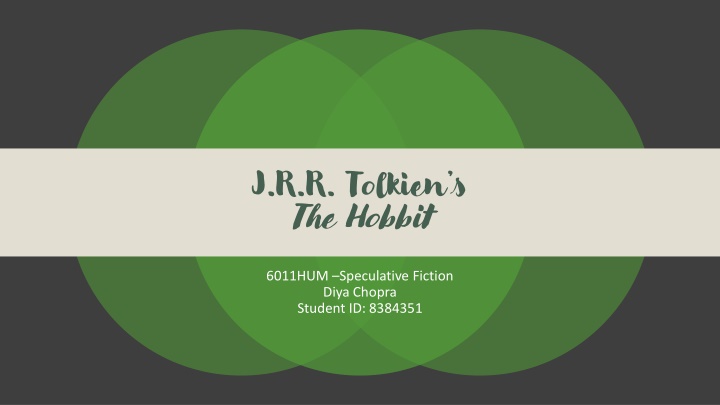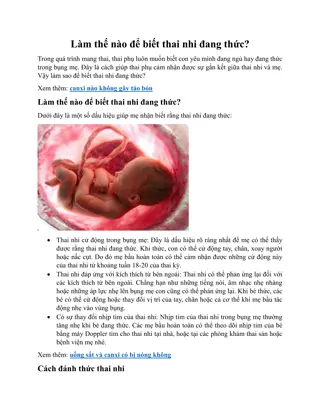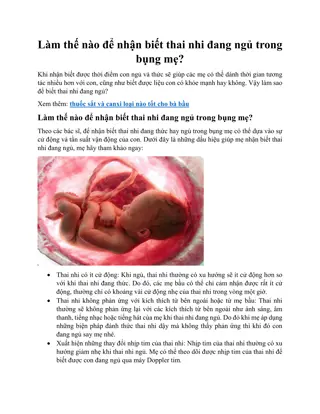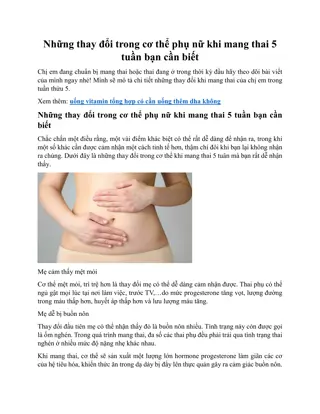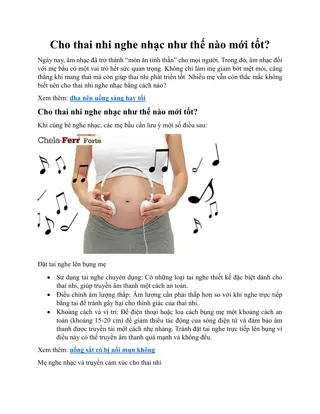The Fascinating World of J.R.R. Tolkien and "The Hobbit
Explore the captivating journey of J.R.R. Tolkien, the renowned author who created Middle-Earth and the masterpiece "The Hobbit." Delve into his literary influences, major life events, key themes, and significant works that shaped the fantasy genre, making him a legendary figure in literature. Discover the rich tapestry of races, languages, and adventures that define his timeless creations.
Download Presentation

Please find below an Image/Link to download the presentation.
The content on the website is provided AS IS for your information and personal use only. It may not be sold, licensed, or shared on other websites without obtaining consent from the author.If you encounter any issues during the download, it is possible that the publisher has removed the file from their server.
You are allowed to download the files provided on this website for personal or commercial use, subject to the condition that they are used lawfully. All files are the property of their respective owners.
The content on the website is provided AS IS for your information and personal use only. It may not be sold, licensed, or shared on other websites without obtaining consent from the author.
E N D
Presentation Transcript
J.R.R. Tolkiens The Hobbit 6011HUM Speculative Fiction Diya Chopra Student ID: 8384351
Key Events in Tolkiens Career Finished his Translation of Beowulf which he had been working on since the 1920s. It was never formally published until 2014. The Hobbit is published in the USA J.R.R Tolkien is born in Bloemfontein, South Africa WW1 fought with the British. It became one of his greatest influences J.R.R. Tolkien dies in Bournemouth, UK Beowulf became another major influence in his essay writing 1892 1911-1915 1914-1918 1925 1926 1937 1938 1947 1973 2012 TCBS was formed (a secret club with his school friends) which later influenced his passion for language and writing. Tolkien is a Professor of Anglo- Saxon at Oxford Pembridge College. The Hobbit is published in the UK On Fairy-Stories is published, another key essay which focuses on his view of fantasy Peter Jackson adapts the novel into a film series due to increasing popularity Beowulf: The Monsters and Critics gets published Tolkien started studying at Oxford and received his English Literature and Language degree in 1915. Co-founded The Inklings with C.S. Lewis Timetoast (2020)
J.R.R. Tolkien Invented a whole new world populated by different races and created the languages for his Middle-Earth . Characters in Tolkien s works are found to use common speech rather than their own language to be able to communicate. The linguistic and cultural differences are reflected in their manner of using it. Tolkien normalised the idea of a secondary world in the fantasy genre. Influenced heavily by:- Victorian Fantasies of George Mac Donald and William Morris Fairy Stories published by the Grimm Brothers / Andrew Lang Wagner s Opera Medieval Icelandic Sagas Figure 1 Tolkien (2001)
Tolkien is regarded as the greatest influence within the fantasy genre (Birch 2009). Criticism Both J.K. Rowling s Harry Potter series and J.R.R. Tolkien s The Hobbit (fantasy novels), have been described as two flagship fantasies (Coats 2010:80) of the 20th & 21st century. on Tolkien s Hobbit was described as a forerunner of a great release of fantasy (Hunt 2001:175). Tolkien The Hobbit and Potter hepatology are positions at two points in time which mark the beginning of the genre s rise to popularity (Berberich 2015:152) The Hobbit is both a distinguished work of children s literature and something like a classic of the fantasy genre (Magoun 2016)
The Hobbit The Hobbit is set within Tolkien s fictional universe and follows the quest of Bilbo Baggins, a titular hobbit, to win a share of the treasure guarded by Smaug the Dragon. Bilbo s adventure takes him from his pleasant rural environment to the more sinister and dangerous territories of Tolkien s fictional universe.
Key Themes Morality of Races Heritage and Emotions Heroism and Bravery Supernatural Gandalf, the Wizard, senses potential in Bilbo, which motivates him to convince the hobbit to undertake the quest. Bilbo s development into a hero is a direct representation of the common man becoming a hero. Tolkien s universe is littered with a diversity of imaginary races (dwarves, elves, trolls, goblins) that differ physically, psychologically and morally. Throughout the novel, Bilbo is faced with challenges and decisions which conflict with his emotions. Bilbo faces internal conflict in regards to his family lineage as one s character, prospects and social position is directly linked to their family heritage. Bilbo s hunger for adventure and desire to escape a life of complacency, prompts his acceptance of the quest, viewing it as a break from his quiet life. Initially, Bilbo is a complacent and timid character who faints at the mention of going on a quest. However, he grows into a more capable character who prevails in the face of adversity. The morally correct races are depicted as being at one with nature whilst the evil races are depicted as being at odds with it. His conflicting emotions of fear and courage are portrayed by the struggle between his Baggins and Took side. The dwarves, a race of exemplar loyalty yet they struggle to understand Gandalf s fascination with Bilbo because they view him as a burden on their own life. Gandalf, symbolizes wisdom and his presence as the hero s supernatural friend/aide, grounds Bilbo, reminding him of his place in the grander scheme of life. Bilbo s bravest moment is considered to be the moment he walks into Smaug s lair as he is reborn into a stronger and more capable character. Bilbo is good because he s a Hobbit but adventurous because he s a Took. most excellent and audacious Hobbit [ ] but the compliments were quite lost on poor Bilbo Baggins, who was wagging his mouth in protest at being called audacious (Tolkien 1995:23) the dwarves wanted to know why he had ever been bought at all [ ] why had the wizard not chosen someone with more sense (Tolkien 1995:85) Bagginses had lived in the neighbourhood [ ] people considered them very respectable [ ] they never had any adventures I have chosen Mr. Baggins and that ought to be enough for all of you (Tolkien 1995:26) Just let anyone say I have chosen the wrong man or the wrong house (Tolkien 1995:26) Took ancestors [..] something not entirely hobbitlike about them [ ] Took-clan would go on adventures [ ] were not as respectable (Tolkien 1995:11) the poor little hobbit could be seen kneeling on the hearth-rug, shaking like a jelly that was melting (Tolkien 1995:23) The Lord of Eagles would not take them anywhere near where men lived. [ ] we are glad to cheat the Goblins of their sport [ ] but we will not risk ourselves for dwarves (Tolkien 1995:100)
Fantasy Fiction Genre Fantasy is a genre of Speculative Fiction, usually set in a fictional universe, created by drawing inspiration from real world myths and folklore. Fantasy is a way to tell stories about the fantastic (Clute and Grant 1993:338). Their impossibility, is what distinguishes them from the Sci-Fi genre. Fantasy Fiction works are usually divided between a world of low and high fantasy Low Fantasy: a world governed by the laws of this world but inexplicable things occur. High Fantasy: set in a secondary world of magic and inhabited by supernatural beings or creatures. Tolkien is well-known for developing the secondary, marvellous world that is now categorised as being high fantasy. Genre Characteristic (n.d.)
A Brief History of Fantasy Fairy Stories by the Grimm Brothers and Charles Perrault (1800s) are particularly large influences to contemporary fantasy works. Edith Nesbit s titles have refreshed fantasy traditions:- A Book of Dragons (1900) Five Children and It (1902) The Phoenix and the Carpet (1904) The Story of the Amulet (1906) Origins of the fantasy genre can be traced back typically to Ancient Greek Mythology, which, fundamentally explained the workings of nature and the supernatural qualities of mythology. A Midsummer s Night Dream (1605) is one of many Shakespeare plays that contain elements of the fantasy genre Heavily influenced by Folklores which were also orally passed down generations among village folk, depicting the heroism of a commoner. Writing about childhood and the collision of magic and the ordinary rather than the morality aspects of magic. 20th Century Ancient Mythology Epics and Legends Shakespeare Gulliver s Travels Grimm Brothers Fantasy Literature Refreshed Fantasy Beowulf (c.700) is the oldest surviving English poem, containing fantasy elements. Johnathan Swift s (1726) work is a social satire which consists of 4 parts, each set in its own fantasy world The Nutcracker (1816) by E.T.A. is a ground-breaking piece of literature . Authors like Hans Christian Anderson and Lewis Carroll were influenced by the Grimm Brother s publications J.R.R. Tolkien s The Hobbit (1937) alongside C.S. Lewis. Chronicles of Narnia and Ursula K. Le Guin's Earthsea (1950-60s) are regarded as the Golden Age of Fantasy. The Legend of King Arthur is also a narrative re-told over the years These titles have helped to forge a clear identity for the fantasy genre and are considered modern epics. A Brief History of Fantasy (n.d.)
Conventions of Fantasy Fictions Characteristics Plot Devices Cook s Tour: traditional journey around the map of a Fantasyland, visiting key points and possibly collecting articles. Quest: the unsuspecting protagonist is told to undertake a quest, presented to them by a magical force. This force usually sees a prophecy or potential in the chosen person. Escape: concept of escapes and rescues are smaller victories that help define the protagonist. Recognition: revelation of what has happened and what is about to. Separation: the group are separated from each other and this spilt is a chance for them to reflect and face their own internal battles. Wrongness: reality-distorting constriction, a disruption of their world s normality . Thinning: the world is about to fade away through death of Gods, transformation of lands or loss of magic. Temptation: chance of the protagonist falling into moral jeopardy. Process of healing: the loose ends are tied up and a sense of harmony is restored. Marriages occur, implementation of a just governance, fertilisation of barren lands. Walking: travelling on foot or even a single horseback enhances inconvenience and makes the journey prolonged and arduous. It also enables the characters to travel through the different landscapes. Clute and Grant (1993:338-339) The Encyclopaedia of Science Fiction (1999)
The Hobbit as a Fantasy Fiction Escape Separation Walking Temptation Cook s Tour Bilbo and the dwarves escape the trolls when Gandalf splits a rock that crushes the trolls. When Bilbo finds the ring in the tunnels and faces Gollum, it is one of the first times he is alone. Bilbo journeys on his quest, predominantly by walking (e.g. walking song in Lord of the rings) which enables Tolkien to emphasise to the readers of the difficulty of the quest whilst portraying Bilbo as a resilient character who grows out of his complacency and fulfil his potential. In Tolkien s sequels, Smeagol found the ring when it was at its most powerful and was tempted to commit violent acts earlier than expected. Smeagol s sealed corruption and descent into villainy is considered an unlucky fate. Throughout the quest, Bilbo encounters creatures from different imaginary races by travelling the different landscapes of Middle-Earth. Bilbo uses the ring to turn invisible which helps him escape from Gollum, by leaping over his head through the passageway. Eventually, Gandalf leaves Bilbo, believing that he is capable enough to complete the quest. After descending into the Goblin s tunnels, Bilbo regains consciousness and absentmindedly pockets a ring he finds, which later helps him to escape the tunnels and Gollum. In the final chapter, Bilbo descends into Smaug the dragon s lair where he confronts Smaug alone. He exhibits extreme bravery is able to overcome his inner battle of fear. Bilbo is constantly tempted by the powers of the ring and is only able to learn to resist it with Gandalf s help. Unlike Epic Heroes, Bilbo is able to use his own strength and abilities to succeed without complete reliance on magic. There are no safe parts in this world [ ] Edge of the Wild now, and in for all sorts of fun [ ] before you could get round the Mirkwood in the North you would be right among the slops of the grey mountain (Tolkien 1995:123) According to Norman Cantor (1992), Tolkien s dramatization of walking was a key service to medieval studies. Biblo resists temptation multiple time throughout the novel. One of the easiest and most accessible forms of temptation Bilbo resists was to give up the quest and return home to his comfortable life. he wanted it because it was a ring of power, and if you slipped that ring on your finger, you were invisible (Tolkien 1995:75) Tolkien isolates Bilbo to define the character and highlight his growth. somehow the killing of the giant spider, all alone by himself in the dark without the help of the wizard or the dwarves or of anyone else, made a great difference to Mr. Baggins[ ] he felt much fiercer and bolder (Tolkien 1995:139) more walking and climbing without breakfast! (Tolkien 1995:213) he galloped away and was soon lost to sight (Tolkien 1995:124) could not resist the desire (Tolkien 1995:137)
Reference and Figures List A Brief History of Fantasy (n.d.) A Brief History of Fantasy [online] available from <https://webcache.googleusercontent.com/search?q=cache:3WJscYx6IwAJ:https://ojs.library.dal.ca/YAHS/article/download/403/388+&cd=5&hl=en&ct=clnk&gl=uk> [4 December 2020] Berberich, C. (2015) The Bloomsbury Introduction to Popular Fiction [online] London; Bloomsbury Publishing Plc. available from <https://books.google.co.uk/books?id=HwarBAAAQBAJ&printsec=frontcover#v=onepage&q&f=false> [5 December 2020] Clute, J. and John Grant (eds.) (1993) The Encyclopaedia of Fantasy [online] London; Orbit. available from <https://www.scribd.com/document/385402695/John-Clute-John-Grant-The-Encyclopedia-of-Fantasy> [4 December 2020] Coats, K. (2010), Fantasy , in D. Rudd (ed.), The Routledge Companion to Children s Literature, London: Routledge, pp. 75-86 Genre Characteristics (n.d.) Genre Characteristics [online] available from <http://webcache.googleusercontent.com/search?q=cache:aAXB6nMsNhIJ:www.ux1.eiu.edu/~cfder/GenreCharacteristicsChart.pdf+&cd=4&hl=en&ct=clnk&gl=uk> [7 December 2020] Hunt, P. (2001), Children s Literature. Oxford: Blackwell. Magoun, J. (2016) General Criticism: The Hobbit Tolkien Studies [online] 13, 235. available from <https://muse.jhu.edu/article/641294/pdf> [4 December 2020] The Encyclopaedia of Science Fiction (1999) Plot Devices in Fantasy Fiction [online] available from <http://sf-encyclopedia.uk/fe.php?nm=plot_devices> [4 December 2020] Timetoast (2020) Major Events in J.R.R. Tolkien s Life [online] available from <https://www.timetoast.com/timelines/major-events-in-jrr-tolkien-s-life> [5 December 2020] Tolkien, J.R.R. (1995) The Hobbit [online] London; HarperCollins Publishers Ltd. available from <https://bibliu.com/app/?query=the%20hobbit#/view/books/9780007322602/epub/OPS/Hobbit_chap- 12.html#page_190> [5 December 2020] Tolkien, J.R.R. (2001), On Fairy Stories , in J.R.R. Tolkien (ed.), Tree and Leaf: Including Mythopoeia and The Homecoming of Beorhtnoth. London: HarperCollins, pp. 1-82. Figure 1: Photograph of J.R.R. Tolkien available from < https://www.britannica.com/biography/J-R-R-Tolkien> [3 December 2020]
